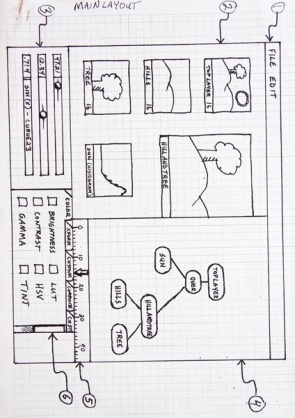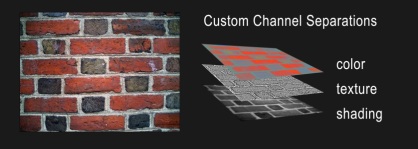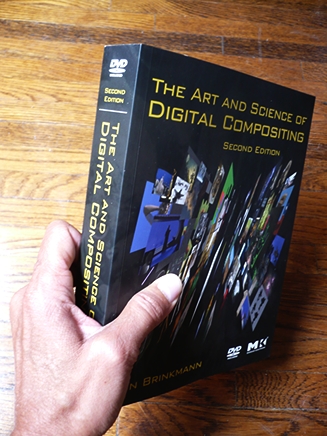A bit of ‘Shake’ nostalgia
May 10, 2009

This one’s purely for those interested in a bit of compositing nostalgia. I was cleaning out some files and came across a bunch of the original design sketches I did for how Shake should behave. So I figured I should scan them in. It’s fun to see how many things made it all the way from paper to product, and also interesting to see those things that didn’t. If you’ve never used Shake, this will be completely uninteresting. If you’re one of the old-timers you’ll probably remember how some of these things evolved and may want to check it out. Take a decade-long walk down memory lane here: http://www.flickr.com/photos/ronbrinkmann/sets/72157617972885456/
Art & Science on the Kindle
March 9, 2009
For those of you that have asked, yes you can purchase a copy of my book for the kindle. The direct link (for those of you in the US) is here
It’s still a hefty 55 bucks but I guess that’s a bit of a discount over the normal list price.
The biggest problem with getting the Kindle version is that you can’t see any of the lush color images that are in the 2nd edition. But a partial solution is to go to here and you can see all the images from the book (except the studio examples, which I can’t legally post) in glorious full RGB. Or sRGB as the case may be.
You can also try and track down a friend who bought the hard-copy and borrow the DVD-ROM that comes with it – the images are on there too, along with some sample materials that you also don’t get with the Kindle version.
If anybody is bold enough to buy the Kindle version, let me know if it’s proving useful. It certainly weighs a lot less!
A whole lotta VFX youtube content
January 11, 2009
Youtube user AgraphaFX has collected and curated a whole lot of visual-effects related videos into one place. Behind the scenes ‘making of’ stuff on everything from Star Wars to Doctor Who – lots of classic old stuff in particular. Worth checking out! www.youtube.com/user/AgraphaFX
Custom Channel Separations
October 4, 2008
Here’s an interesting little blogpost from a guy (David Aughenbaugh) that I was chatting with at Siggraph.
http://www.vfxconnection.com/DavidAughenbaugh/blog/
I haven’t had a chance to play with it yet so can’t really attest to how often it applies in real-world situations – be curious to hear what other people think. Still, I’m a big fan of using alternate representations of an image as a method for developing new techniques. I remember when I first discovered all the fun stuff that could be done by tossing something into HSV space and playing with the channels before coming back to RGB.
We always wanted to get some more frequency-based tools into Shake but management had a hard time figuring out how it was going to sell more licenses relative to features that made for good data-sheets. Would’ve been cool…
Animation, Garbage Bags, and the Uncanny Valley
August 30, 2008
(Cross-Posting from my Digital Composting blog)
The inflatable trash-bag street art of Joshua Allen Harris (someone create a Wikipedia article for this guy!) has been floating around the youtubes for several months now but I just watched a recent video and was struck again by how organic the sculpture’s movements can feel.
As someone who has spent a not-inconsiderable amount of time dealing with what it takes to make animated (CG) characters feel alive, it’s rather humbling to see what some random air-currents can invoke. Watch the video that I’ve linked to above and pay attention to how much you naturally tend to assign emotional overtones to the action you’re seeing. There are parts where you’d swear there’s an intelligence/awareness behind the movements of this creature – I see shyness, curiosity, etc. I can easily build up a narrative in my head about how this lonely creature has come down out of the wilderness and is trying to understand how to survive on the streets of the big city.
It’s no secret that our brain tries to assign familiar patterns to the unfamiliar so it’s not all that surprising that we would tend to mentally map this four-legged inanimate object into a standard animal-model. But is there more to it? Does the actual construction of the sculpture contribute to this, where appropriate placement of leg or neck joints can cause the body to move in a more lifelike fashion? Does the artist ‘tune’ the construction to enhance this?
More importantly, does the fact that everything is based on an ‘engine’ that has a significant quantity of randomness in it teach us something about how we should approach our own animations? One of the most obvious problems with poorly-done computer animation is that it can feel far too deliberate and predictable – and consequently it has no soul. Maybe introducing a bit of randomness, particularly if it’s partially influenced by a number of environmental factors, could help significantly with the problem of creating a personality.
One of the most amazing things in the video comes from the fact that the air-currents which inflate and surround the creature are modified as people come near. This, consequently, affects the movement of the sculpture itself, making it seem as if it is intentionally interacting with anybody who approaches. It will sometimes flinch away if someone moves too quickly but it can also decide to show spontaneous affection, leaning it’s body against someone who is reaching out to pet it, in a motion that I’ve seen cats do a thousand times. (Take a look at about the 55-second mark).
Has anybody ever analyzed the micro-movements a human makes whenever someone new enters the room, or walks nearby, or starts to speak? In my book I have a chapter that focuses on how all the lights in an environment interact with each other and make the point that ultimately everything is a light source – it’s either generating light or it’s reflecting it. And if you introduce a new object into an environment – set a red ball down next to something – you need to recognize that the light reflecting off of that ball will affect everything that it is near.
But we need to recognize that the movement of a living creature is much the same. Our head will turn slightly whenever a new noise occurs, be it the sound of a door opening or a car honking in the street. We constantly readjust our position and stance relative to others in the room as they move about and come closer to our personal comfort zone. This is a concern even beyond the boundaries of animation. With so many movies being constructed in postproduction – people shot on bluescreen and added to a scene later – we have exactly the same problem. Yes, an actor can do their best to react to a co-star that isn’t actually on stage with them at the same time, but can they also do a convincing job of reacting to all the other missing stimuli? The characters and objects and sounds and smells that will surround them? These reactive movements may be tiny tiny tiny in some cases but they’re definitely there, and I’m sure we notice them if they’re missing. Maybe not consciously, but in the back of our brains the primitive subconscious who has a deep-seated distrust for the unnatural and the unfamiliar will start to scream ‘FAKE’ as things slip towards unreality.
Which of course takes us straight to the concept of the Uncanny Valley. The term has generally been applied to the ‘creepiness’ factor we feel if a face (robot/animatronic or computer-generated) is nearly believable but not completely. If it’s cartoon-like then we’re fine with it – our mind can interpret it as purely symbolic and the reality filter doesn’t click in. (See Scott McCloud’s brilliant Understanding Comics). But that borderline area where it’s trying to be real but doesn’t succeed – that’s the deadly valley.
And I would claim that this problem exists any time we’re trying to emulate reality, including for instance the bad physics of a character doing a stunt that relies on wires (which we later remove). When we see a superhero fly, it’s rarely the actual flying that feels strange, it’s almost always the take-off or landing. The flying itself is too broadly unnatural for us to worry about, but we’re all familiar with what it should look like when someone jumps or when they touch ground again after jumping. Then again I suppose you could probably just broadly categorize bad acting in general as being firmly planted at the bottom of the uncanny valley…
Getting back to animation, I’m wondering if it makes sense to develop tools that can be applied as a post-process after all the primary animation is done. Tools that analyze the rest of the environment/scene/characters and then algorithmically add in the final bits of nuance mentioned above to produce subtleties that are appropriate and motivated and organic.
Book used in classrooms?
July 31, 2008
Hey, a quick question for everybody – I’m trying to figure out which schools are using my book in the classroom. And by ‘classroom’ I mean any sort of training institution, including online. If you’ve got any insight into this, leave me a note in the comments below. ( Ideally some details about the name of the institution, the specific class it was used in and even the name of the teacher would be handy.) Thanks!
more on the missing DVD’s…
June 21, 2008
If you live in Europe (the only place where this happened, allegedly) and received a copy of the book without a DVD, contact eurobkinfo@elsevier.com (European customer service for my publisher) and they’ll take care of you. If that doesn’t work for some reason, try the main (US) customer service – usbkinfo@elsevier.com . Sorry for the hassle!
New Website, etc…
June 20, 2008
For those of you who got here directly via www.digitalcompositing.com, you’ve probably noticed that there’s a new website up there. It features a variety of things that I hope will prove useful for readers of the book. Specifically, here’s the most important things that I’ve put up there:
1) Forum Discussions. If you want to discuss/argue/refute or complain about something in the book, here’s the place to do it. Rather than try to break things up into arbitrary categories I figured I’d just let the discussions flow based on the chapters of the book.
2) User-modifiable Wiki’s for the Glossary and Appendix A of the book. These two sections seemed like ideal candidates to open up to the user community who can correct, extend and enhance what is in the published edition. Feel free to add new terms, etc. And since it is a Wiki it should be reasonably self-policing. If someone posts something you don’t agree with (or that just doesn’t belong there), feel free to change it!
3) Social stuff: I went ahead and created a Facebook group for compositing – not sure how much traction this will have but I figured it could be convenient to have a common place where people can get in touch with each other. The ‘Frappr’ map that I originally set up a few years ago is still active as well – click on the link and go put a pin in the map for where you’re located.
Incidentally, for those of you who normally follow this blog via an RSS feed subscription, you’ll need to change where your feed is pointing. Click on the “Entries RSS” link over on the right and you’ll get to the new one.
A big ‘Thank You’ to fxguide/fxphd for their help setting this up and hosting it. Especially to Mark Dascoli who wrangled all the main page layout for me. Thanks Mark!
For all of this stuff, feedback is very welcome. Just leave comments here in the blog or within the appropriate forum and I’ll definitely see it. Looking forward to hearing what people think. Thanks for visiting!
Actual confirmed sighting of new book
June 20, 2008
Well, my author copy has just shown up. Woohoo! Looks pretty good, although I’ve been afraid to do more than look at a couple of pages because I don’t want to find any of the horrible mistakes that I’m sure are waiting for me 🙂 From what I can tell the images look reasonably good, although a bit darker than I’d hoped. Sigh. But at least there’s a DVD in the back of it!
So hopefully this means that the book is shipping everywhere now. Amazon still shows it’s not shipping immediately but maybe that’ll change by next week.
Book Status… and missing DVD’s
June 10, 2008
Well, it looks like copies of the book have started to ship. Sort of.
Unfortunately this isn’t the good news that I was hoping for because apparently any books that have shipped out so far were all missing the DVD that is supposed to accompany the book! Grr.
Here’s the full story, as far as I can tell: The book was sent back to the states (after being printed in China) to my publisher’s warehouse where the DVD’s were then supposed to be pasted into the back of the book. (Yeah, I know it seems a bit silly that they just didn’t bind the DVD’s into the book at the printer’s, but don’t get me started on that whole fiasco). Revised ship date is scheduled to be on June 16th. However, in the meantime, my publisher tells me that:
“a small number of the books were mistakenly shipped out without the DVDs. Our Inventory Management and Customer Service departments are running reports of all already sold copies and will draft and send a letter explaining the situation to each of the customers who mistakenly received a copy without the DVD.”
I don’t know how ‘small’ a number this actually is – hopefully not too many. Hey, maybe they’ll become collector’s items :-).
At any rate, if you were indeed one of the lucky few that got the book w/o the DVD, presumably you’ll be hearing from someone… although I’m not sure exactly how they know who you are. Big Brother is watching. I’ll try to get a contact email for someone at my publisher as well and post it here.
What’s actually on the DVD? Primarily it contains (as with the 1st edition) digital copies of all the images that are featured within the book. I also included some of the (Shake) scripts that were used to put together the example images. More importantly, a couple of the studios allowed us to include digital images from a couple of the case-studies. By far the most extensive of these is a shot from Ep3 of Star Wars – we were able to get the full shot (all the elements as well as the Shake script used to put it together) which should give a nice idea of how a real-world shot comes together. There are a few other miscellaneous pieces – some sample bluescreen footage that was generously provided by fxphd and The Pixelcorps.
So, that’s where we stand. Presumably this is all rolling along well now and the book will be shipping in less than a week. Thanks for everybody’s patience and thanks, too, for all the interest that people are showing in the new edition – I hope you all find it useful!




